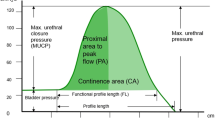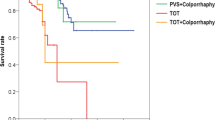Abstract
Introduction and hypothesis
We evaluated outcomes of an inelastic retropubic sling in patients with intrinsic sphincteric deficiency (ISD).
Methods
This is a retrospective review of women diagnosed with ISD according to urodynamic parameters who underwent a retropubic suburethral sling surgery using a tape with minimal elasticity. All patients in the study where followed up at 2, 6, and 24 weeks and yearly. Outcome measures included self-assessed satisfaction, daily incontinence episodes and pad usage, standardized stress test, postvoid residual volume, and surgical complications.
Results
Two hundred and forty-seven patients were involved in this study, with a median follow-up of 43 [interquartile range (IQR) 22–77] weeks and a minimum of 12 weeks. Two patients (0.008 %) had a positive stress test postoperatively. There was a decrease in daily incontinence events (median 1.5–0) (p < 0.001) and pad usage per day (median 1.5–0) (p < 0.001). Two hundred and sixteen (87.4 %) patients reported subjective improvement in symptoms. Urinary retention was found in 18 (7.2 %) patients, and 19 (7.7 %) patients required reintervention, mostly with bulking agent injections for persistent incontinence. No tape-related mesh exposures were reported.
Conclusion
Retropubic suburethral inelastic slings represent a good option for treating patients with ISD, with satisfactory continent rates and low postoperative complications.

Similar content being viewed by others
References
Kawasaki A, Wu J, Amudsen L et al (2012) Do urodynamic parameters predict persistent postoperative stress after incontinence after midurethral sling? A systematic review. Int Urogynecol J 23:813–822
Kim S, Kim Y, Yoo D et al (2011) Clinical factors associated with low valsalva leak point pressure among women with stress urinary incontinence. Int Neurourol J 15:211–215
McGuire E (1995) Diagnosis and treatment of intrinsic sphincter deficiency. Int J Urol 2:7–10
Guerette NL, Bena JF, Davila GW (2008) Transobturator slings for stress incontinence: using urodynamic parameters to predict outcomes. Int Urogynecol J 112:97–102
Nager CW, Sirls L, Litman HJ, Richter H, Nygaard I, Chai T, Kraus S, Zyczynski H, Kenton K, Huang L, Kusek J, Lemarck G, Urinary Incontinence Treatment Network (2011) Baseline urodynamic predictors of treatment failure 1 year after mid urethralsling surgery. J Urol 186(2):597–603
Choo G, Kim D, Park H et al (2012) Long-term outcomes of tension-free vaginal tape procedure for treatment of female stress urinary incontinence with intrinsic sphincter deficiency. Int Neurourol J 16:47–50
Gungorduk K, Celebi I, Ark C et al (2009) Which type of mid-urethral sling procedure should be chosen for treatment of stress urinary incontinence with intrinsic sphincter deficiency? Tension-free vaginal tape or transobturator tape. Acta Obstet et Gynecol 88:920–926
Doo C, Hong B, Chung B et al (2006) Five year outcome of the tension-free vaginal tape procedure for treatment of female stress urinary incontinence. Eur Urol 50:333–338
Rezapour M, Falconer C, Ulmsten U (2001) Tension-free vaginal tape (TVT) in stress incontinent women with intrinsic sphincter deficiency (ISD)—A long-term follow-up. Int Urogynecol J 2:12–14
Pariente JL, Villars F, Bram R, Ibarboure E (2005) Mechanical evaluation of various suburethral tapes used for the treatment of stress urinary incontinence. Prog Urol 6:1106–1109
Ridgeway B, Chen C, Paraiso M (2008) The Use of Synthetic Mesh in Pelvic Reconstructive Surgery. Clin Obstet Gynecol 51(1):136–151
Dylewski DA, Jamison MG, Borawski KM, Sherman ND, Amundsen CL, Webster GD (2007) A statistical comparison of pad number versuspad weights in the quantification of urinary incontinence. Neurourol Urodyn 26:3–7
Pollak J, Neimark M, Connor J, Davila GW (2004) Air charged and microtransducer urodynamic catheters in the evaluation of urethral function. Int Urogynecol J 15:124–128
Zoorob D, Karram M (2012) Role of autologous bladder-neck slings: a urogynecology perspective. Urol Clin North Am 39(3):311–316
Ostermann KV, Davila GW (1993) Intraoperative urodynamics in patients undergoing a suburethral sling procedure. Int Urogynecol J 4:408
David-Montefiore E, Frobert J, Grisard-Anaf M et al (2006) Peri-operative complications and pain after the suburethral sling procedure for urinary stress incontinence: a french prospective randomized multicentre study comparing the retropubic and transobturator routes. Eur Urology 49:133–138
Nanzemi T, Kobashi K, Govier F (2007) Synthetic sling options for stress urinary incontinence. Curr Bladder Dysfunct Rep 2:79–85
Amid P (1997) Classification of biomaterials and their related complications in abdominal wall hernia surgery. Hernia 1:15–21
Ogah J, Cody J, Rogerson L (2009) Minimally invasive synthetic suburethral sling operations for stress urinary incontinence in women. Cochrane Database Syst Rev 4:CD006375
Krauth J, Rasoamiaramanana H, Barletta H et al (2005) Sub-urethral tape treatment of female urinary incontinence—Morbidity assessment of the trans-obturator route and a new tape (I-STOP®): A multi-centre experiment involving 604 cases. Eur Urol 47:102–107
Oh T, Shin J, Na Y (2012) A comparison of the clinical efficacy of the transobturator adjustable tape and transobturator tape for treating female stress urinary incontinence with intrinsic sphincter deficiency: short-term results. Korean J Urol 53:98–103
Jeon M, Jung H, Chung S et al (2008) Comparison of the treatment outcome of pubovaginal sling, tension-free vaginal tape, and transobturator tape for stress urinary incontinence with intrinsic sphincter deficiency. Am J Obstet Gynecol 199:76.e1–76.e4
Schierlitz L, Dwyer P, Rosamilia A et al (2008) Effectiveness of tension-free vaginal tape compared with transobturator tape in women with stress urinary incontinence and intrinsic sphincter deficiency. Obstet Gynecol 112:1253–1261
Araco F, Gravante G, Sorge R et al (2008) TVT-O vs. TVT: a randomized trial in patients with different degrees of urinary stress incontinence. Int Urogynecol J 19:917–926
Skala C, Renezeder K, Albrich S et al (2011) The IUGA/ICS classification of complications of prosthesis and graft insertion. Int Urogynecol J 22:1429–1439
Wang K, Neimark M, Davila G (2002) Voiding dysfunction following TVT procedure. Int Urogynecol 13:353–358
Abouassaly R, Steinberg J, Lemieux M et al (2004) Complications of tension-free vaginal tape surgery: a multi-institutional review. BJU Int 94:110–113
Guezzi F, Serati M, Cromi A et al (2006) Tension-free vaginal tape for the treatment of urodynamic stress incontinence with intrinsic sphincteric deficiency. Int Urogynecol J 17:335–339
Conflicts of interest
GW Davila: honoraria, American Medical Systems, CL Medical, Astellas, Warner-Chilcott; consultant, American Medical Systems, Coloplast, CL Medical, Astellas; research funding, CL Medical. Other authors: No conflict of interest
Author information
Authors and Affiliations
Corresponding author
Rights and permissions
About this article
Cite this article
Jijon, A., Hegde, A., Arias, B. et al. An inelastic retropubic suburethral sling in women with intrinsic sphincter deficiency. Int Urogynecol J 24, 1325–1330 (2013). https://doi.org/10.1007/s00192-012-2007-5
Received:
Accepted:
Published:
Issue Date:
DOI: https://doi.org/10.1007/s00192-012-2007-5




